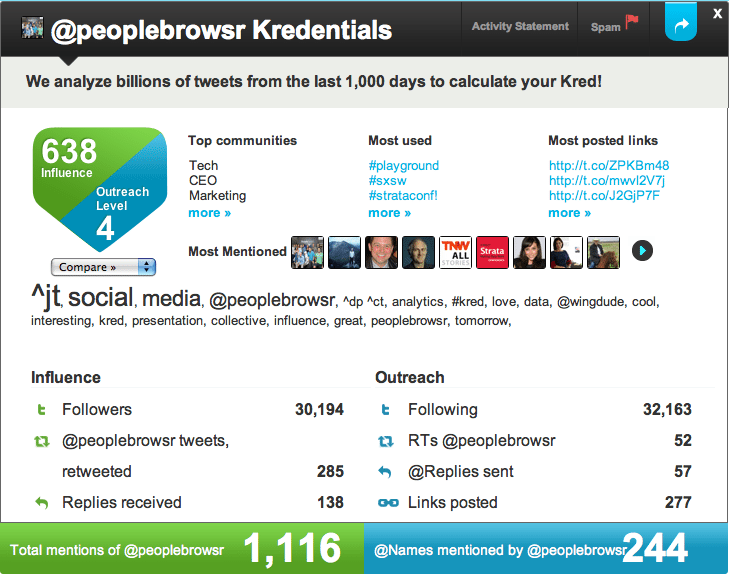![]()
Lady Gaga has 14,161,587 Twitter followers.
That’s a whopping level of influence, but good luck getting her to mention your brand in a tweet. And what does Lady Gaga know about your industry, anyway?
Kred wants to take us back to influencer reality. No, Lady Gaga is not the only voice (or Twitter handle) of importance. And to the best of my knowledge, she is relatively useless when it comes to something like B2B social media influence.
The often overlooked reality is that small networks of what we’ll call “normal people” are actually brimming with the influence your brand craves.
Kred claims to help you to find those valuable communities and influencers.
But this whole online influence score spiel probably sounds a bit familiar, right? Chances are you’ve heard of influence measurement tool darling Klout. Here’s a fun fact: it just so happens that these competitors not only share the same market, but the very same office space in San Francisco. That’s got to be awkward.
But while both neighbors Kloud and Kred seek to shed light on the same metric, they have different philosophies on the true source of online influence.
Give some, get some
Kred’s take on digital relationships is that they are actually extraordinarily similar to real life networking. If a digital relationship involves the same give and take, or reciprocity, why wouldn’t we measure both quantities?
That’s why Kred measures not only influence, but also adds generosity the mix. This metric looks at the retweets, mentions and follows that you share with others. The other differentiating point for Kred lies in their consideration of real life credentials – so that Nobel Peace Prize or spelling bee title on your shelf will be taken into account when calculating your score.

The new influence metric from PeopleBrowsr is slowly rolling out this week via email and Twitter invites. We chatted with Andrew Grill, CEO of PeopleBrowsr UK this week. Here’s what he had to say about the release of Kred and what it means for the marketers of the world.
What kind of value does Kred offer to brands and marketers?
AG: Kred helps brands on two levels. First, it helps brands find influencers based on communities. A brand can come to Kred and say, “I’m looking for influencers in XYZ market.” Kred will then find or even formulate that community. For example, one of our UK clients was looking to find influencers within the media to reach out to, so we built a custom community called “Media Moguls.”
Quality of content is of increasing importance these days. Does Kred take this into account?
AG: Influence scores are based on credentials within a specific community. The rate at which community members retweet your content or actively participate in conversations with you really rides on you ability to produce worthy content. If you want influence within a community, you need to genuinely resonate with that community.
Let’s take a step back. What is digital influence anyway, and why should it matter to a brand?
AG: This is the age of fragmented markets. There are so many channels out there that brands are desperate to find out who the key influencers are. It’s true that Justin Bieber and Lady Gaga have tons of influence, but good like trying to get them to mention your brand our product. What we are realizing is that the influencers in smaller, local communities are rockstars in their own right. It’s about getting a person who is influential within a specialized community to authentically mention your product. This is peer advocacy, and it works for brands.
What lonelybrand likes about Kred
- Community – the key element for brands. The ability to find the communities that will care about your product or service, and the opportunity to pinpoint the top influencers among these groups could make brand marketers’ jobs a whole lot easier.
- Transparency – unlike its competitor, Kred is up front about how your score is calculated down to each and every tweet, retweet, mention, follow, like…you get the point.
- Analytics – PeopleBrowsr’s relationship with Twitter goes back to 2008, and since then the analytics company has stockpiled 55 billion tweets on which to base their data.
Is it really that easy?
- As thorough as this tool might be, we have to wonder whether influence is really a quantifiable value. Does it really all come down to a number?
- Kred looks at Twitter, Facebook and LinkedIn interaction, with Google+ data slated to arrive once the API is released. But what about all of the other influential platforms on the web, from blogs to Digg and beyond?
- We all know the rules of the web: if it’s transparent it’s vulnerable. That goes for algorithms as complex as Google (which is only transparent by observation) and metrics like influence. What’s to stop sneaky internet denizens from using Kred’s system against itself to appear more influential than they really are?